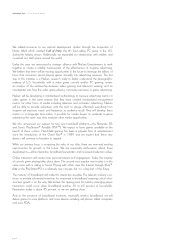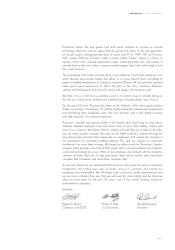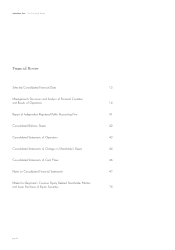Blizzard 2004 Annual Report Download - page 14
Download and view the complete annual report
Please find page 14 of the 2004 Blizzard annual report below. You can navigate through the pages in the report by either clicking on the pages listed below, or by using the keyword search tool below to find specific information within the annual report.
Critical Accounting Policies
We have identified the policies below as critical to our business operations and the understanding of our financial
results. The impact and any associated risks related to these policies on our business operations is discussed throughout
Management’s Discussion and Analysis of Financial Condition and Results of Operations where such policies affect our
reported and expected financial results. For a detailed discussion on the application of these and other accounting
policies, see Note 1 to the Notes to the Consolidated Financial Statements included elsewhere in this Annual Report.
The preparation of financial statements in conformity with generally accepted accounting principles requires manage-
ment to make estimates and assumptions that affect the reported amounts of assets and liabilities at the date of the
financial statements and the reported amounts of revenues and expenses during the reporting period. Actual results
could differ from those estimates.
Revenue Recognition. We recognize revenue from the sale of our products upon the transfer of title and risk of loss
to our customers. Revenue from product sales is recognized after deducting the estimated allowance for returns and
price protection. With respect to license agreements that provide customers the right to make multiple copies in
exchange for guaranteed amounts, revenue is recognized upon delivery of such copies. Per copy royalties on sales that
exceed the guarantee are recognized as earned. In addition, in order to recognize revenue for both product sales and
licensing transactions, persuasive evidence of an arrangement must exist and collection of the related receivable must
be probable. Revenue recognition also determines the timing of certain expenses, including cost of sales—intellectual
property licenses and cost of sales—software royalties and amortization.
Allowances for Returns, Price Protection, Doubtful Accounts and Inventory Obsolescence. In determining the appropriate
unit shipments to our customers, we benchmark our titles using historical and industry data. We closely monitor and
analyze the historical performance of our various titles, the performance of products released by other publishers and
the anticipated timing of other releases in order to assess future demands of current and upcoming titles. Initial volumes
shipped upon title launch and subsequent reorders are evaluated to ensure that quantities are sufficient to meet the
demands from the retail markets but at the same time, are controlled to prevent excess inventory in the channel.
We may permit product returns from, or grant price protection to, our customers under certain conditions. In general,
price protection refers to the circumstances when we elect to decrease the wholesale price of a product by a certain
amount and, when granted and applicable, allows customers a credit against amounts owed by such customers to
Activision with respect to open and/or future invoices. The conditions our customers must meet to be granted the right
to return products or price protection are, among other things, compliance with applicable payment terms, delivery to us
of weekly inventory and sell-through reports, and consistent participation in the launches of our premium title releases.
We may also consider other factors, including the facilitation of slow-moving inventory and other market factors.
Management must make estimates of potential future product returns and price protection related to current period
product revenue. We estimate the amount of future returns and price protection for current period product revenue
utilizing historical experience and information regarding inventory levels and the demand and acceptance of our
products by the end consumer. The following factors are used to estimate the amount of future returns and price
protection for a particular title: historical performance of titles in similar genres, historical performance of the hardware
platform, historical performance of the brand, console hardware lifecycle, Activision sales force and retail customer feed-
back, industry pricing, weeks of on-hand retail channel inventory, absolute quantity of on-hand retail channel inventory,
Activision warehouse on-hand inventory levels, the title’s recent sell-through history (if available), marketing trade
programs and competing titles. The relative importance of these factors varies among titles depending upon, among
Management’s Discussion and Analysis of Financial Condition
and Results of Operations
Activision, Inc. — 2004 Annual Report
page 16
























